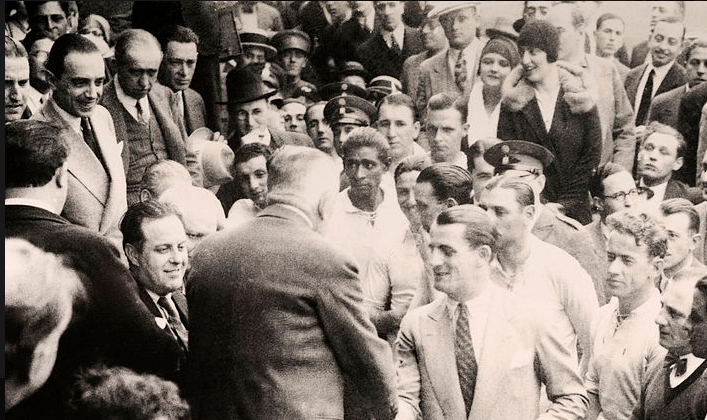10 Tales of Intrigue From the First FIFA World Cup

From the ship that carried all the European teams to South America for the inaugural FIFA World Cup, and the impeccably dressed referee who ended a match “by mistake” six minutes before time, to the argument between eventual champions, hosts Uruguay, and runners-up Argentina over which ball to play in the final, the tournament had many intriguing tales…
The Conte Verde
The Conte Verde was commissioned in 1923, and sailed out of the shipyards of William Beardmore & Co in Dalmuir, near Glasgow, destined for history. Florentine craftsmen were hired to design the first class saloons, and a painting by Alberto Cavalieri hung on the wall of the main staircase. The boat was built for the Genoese Lloyd Sabaudo line and named the Conte Verde, after Amadeus VI, a 14th-century Count of Savoy. Bear with this. The boat’s history is key to understanding the beginning of the World Cup. Without the ship after all, there would’ve been no World Cup.
This was the vessel that couriered four national teams (Romania first, joined by France, Belgium and Brazil), three referees, FIFA officials, Jules Rimet and the trophy itself (packed nonchalantly, inside Rimet’s suitcase). The journey took them a fortnight (Brazil expectedly, joined them much later on) and records show that none of the teams, discussed tactics, played friendlies or exchanged much in terms of pleasantries through the trip. That left Yugoslavia, who were always different. Different and late.
By the time they decided to come along for the World Cup, the Conte Verde was fully booked. And so, they set sail from Marseille, after a three-day train journey, on the pleasure cruiser Florida. The only African representatives, Egypt, were due to join them only for their boat to get slowed down by a storm in the Mediterranean Sea, and the Florida left without them. Egypt sent their apologies and the tournament continued with an awkward 13 teams. Not for the superstitious, was the 1930 World Cup.
Qualification by invite
It will surprise you to know that countries we now consider World Cup staples, weren’t a feature at the first World Cup. There was no qualification of course. Teams were invited, and if they were enthused enough, they could get themselves there.
Sweden, Spain, Italy and the Netherlands had been sufficiently excited about the idea of a World Cup to volunteer to host the first one, but less keen when Uruguay was given the honour. Not that it much mattered. Uruguay were the powerhouse of the game in the period.
They had won gold in the 1924 and 1928 Olympics, and were celebrating the hundreth year of their independence (one of the chief reasons why Rimet decided to ship everyone there) and had in their team, the ever forgotten Andrade.
Andrade, the original black icon
Who Andrade? Before Pele, there was Andrade. Jose Leandro Andrade. The first black icon of football was the best player of his era on the pitch, a key figure in their successive gold at the Olympics.
The son of a former slave, he was born in Salto, a city that would, half a century later, also produce Luis Suarez and Edinson Cavani. Unfortunately, for those who followed the game thanks to a colonial influence, Andrade barely features in history. The English of course, only got into the World Cup in the 1950s and didn’t consider Olympic football worthy of participation in the 1920s.
Andrade played as a ‘half back’ and was the creative fulcrum of the Uruguayan team. Despite being slower, blinded in one eye, and an alcoholic by the time the World Cup landed on his shores, Andrade was good enough to traumatise opposition into submission. He was named in FIFA’s ‘team of the tournament’ in 1930, and his appearance in the final was his last for Uruguay. He died in 1957, a penniless alcoholic at an asylum in Montevideo. He was 56.
Argentine magic
Uruguay’s chief opponents: Argentina. The Argentines then were the Argentines of now. Dirty, despicable, cheats. Disgusting, dramatic devils. And magicians too. Although, the team didn’t get much sleep through the tournament, if reports are to be believed. The night before their opening game against France, they were kept awake by celebrations among Montevideo’s large French population, celebrating Bastille Day. And so, they took their revenge on the field, popping, snapping and physically dismantling the French—who hobbled on for 81 minutes with nine fit men—before scoring from a free kick in the 81st minute to win the game. The scorer Luis Monti holds the unbreakable honour of having played the World Cup for two different nations (he represented Italy in 1934).
Final whistle in 84th minute!
If Argentina’s victory in the game doesn’t seem that dubious—physicality after all is now an expected part of the game—then consider this. At the end of the match, the French forward Marcel Langiller ran clear on goal, looking certain to score, only for the referee to blow for full time. Erm. Except. Only 84 minutes had been played. The referee Gilberto Rego—unassisted by VAR mind—duly noticed his mistake and brought the teams back on the field to finish the game.
France’s momentum was obviously lost and soon so the game. Argentina didn’t let up though. They won their next game 6-3 against Mexico (in a game awarded five penalties, but only one converted) and then won a game against Chile, the highlight of which was a mass brawl (started by the indomitable Monti). By the time the knockout rounds started, Argentina were the most unpopular team of the World Cup. And then, they beat the USA 6-1 in the semi finals—after injuring one American player within the first ten minutes.
Well-dressed referees
Refereeing standards at the 1930 World Cup left much to be desired, but refereeing attire was top notch. A picture of the final tells you all you need to know. Kits were personal, and Belgium’s John Langenus, decided to sport a shirt, tie and jodhpurs for the final. Really.
Unstoppable hosts
The other semi-final wasn’t too different. Yugoslavia, the youngest team of the tournament, scored the first goal against the hosts, but were eventually knocked out of the park by the Uruguayans, who came back to win 6-1. And so, everyone got the final they wanted.
Matchball argument
But also most feared. Such was the animosity and excitement that the teams couldn’t agree on a match ball. So, the first half was played with Argentina’s and the second with Uruguay’s (Argentina duly won 2-1 with their ball, only to lose 3-0 with Uruguay’s).
Missing Romanian star
Back to the Conte Verde then, for the European teams who didn’t manage to touch the trophy. They repeated their marathon journey back home, albeit with a little more drama. The Romanian midfielder Alfred Eisenbeisser took ill during the voyage and had to be interned in Genoa, for treatment.
His absence upon arrival of the Romanian team in Bucharest provoked unrest though. Soon enough, rumours about his death flew across the country. His distraught mother, organised a wake to honour her son. Right on cue, on the morning of his wake, Eisenbeisser returned home. Not only was he alive, he was well enough to compete as a figure skater for Romania in the 1934 and 1938 European Championships and in the 1936 Olympics. He finished 13th in the pairs.
Death of the World Cup ship
As for the Conte Verde, alas, the ship did finally die. But even its death was glorious. In 1943, the boat was moored in Shanghai, when news of Italy’s surrender to the Allied forces broke through. The crew were ordered to destroy the ship rather than let it fall into Japanese hands. It was sunk in the most inconvenient location possible, preventing ships from entering or leaving the Japanese docks. In 1944, it was raised, repaired only to be bombed back down by an Allied bomber. Six months on, the Japanese salvaged it, renamed it, Kotobuki Maru and used it to move their troops, till finally it was beached in 1945.
Get the latest reports & analysis with people's perspective on Protests, movements & deep analytical videos, discussions of the current affairs in your Telegram app. Subscribe to NewsClick's Telegram channel & get Real-Time updates on stories, as they get published on our website.
























